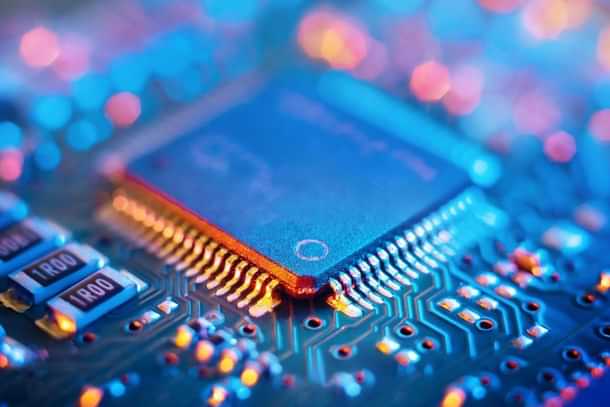Tech
Why India Must Up The Incentives Ante For Semiconductor Manufacturers
Tushar Gupta
Dec 03, 2021, 02:15 PM | Updated 03:02 PM IST
Save & read from anywhere!
Bookmark stories for easy access on any device or the Swarajya app.


The Narendra Modi government’s obsession with getting a semiconductor manufacturing plant in India is an open secret, and in the larger scheme of things, it’s the right obsession to have.
Supply chain vulnerabilities, especially with respect to the imminent reunification of Taiwan by force or otherwise, dependence on China in the face of border conflicts with India and trade war with the United States, and the growing demand of a digitised economy with supply-side constraints warrant urgent investments and incentives for willing manufacturers looking to set up shop in India.
The early plans involved offering incentives around a billion dollars, but if a recent report from Bloomberg is to be believed, the incentives have been increased ten-fold to $10 billion or almost Rs 76,000 crore, to be given over a period of six years.
Assuming the rumours are true, the government must be credited for the intent, for the semiconductor industry can no longer be viewed from a technology perspective, but strategic, for one country’s actions or sanctions can cripple the other, causing a domino effect in other industries as well.
Perhaps, that is what is driving China to invest close to $1.4 trillion in their semiconductor ambitions over the next five years to achieve self-reliance and decouple from the American technologies. Yet, even with an investment which is 140 times the incentives being proposed by India, it won’t be smooth sailing.
When we imagine manufacturing, we imagine assembly, testing, marking and packaging. Perhaps, this works best for mobile phones, as was the case with some local manufacturers in the early 2010s. Import the necessary parts, put them together, and Bob’s your uncle. However, with semiconductors, it is far more elaborate.
There is the challenge to acquire the raw materials, starting with silicon. Then there is designing of chips which comes with its challenges. Then comes the muscle of manufacturing capability which requires the most intricate machinery known to mankind, and finally, achieving the scale of production. Now, none of this, even with a trillion dollars, can be set up in a year or two, and warrants long-term planning.
For instance, China can manage silicon, being the majority producer of the world, but that does not solve its design problems. Chip design needs access to complex instruction set architecture (ISA), or what gives the chip its computing power. However, the ISA, under strict IP controls, comes from Intel, an American company, and Arms, a British company currently in the middle of an acquisition by NVIDIA. For China, this dependence is an issue, given it can be rendered helpless in the event of a war or a fresh round of sanctions.
Even if the design is in place, getting the manufacturing going is another challenge. This warrants electronic design automation or EDA which helps put the billions of transistors on pieces of silicon.
Fifty years ago, when Intel released its first microprocessor, the chip contained only 2,300 transistors with a node size of 10 microns or 10 millionths of a metre. However, after four decades of leadership, Intel was displaced by Taiwan Semiconductor Manufacturing Company (TSMC) and Samsung. Today, we have transistors with a dimension as little as 5 nanometres or 5 billionths of a metre. To put things in perspective, an average human hair is 20,000 times the size of a transistor being used by TSMC or Samsung, and a transistor is many times smaller than a virus.
The increase in the number of transistors within the semiconductor reflects the intricacy of the entire process and consequently more efficient and powerful devices, thus adding to the computing prowess.
Intel 8086, which came out in 1979, had 29,000 transistors. Pentium in 1993 had 3.1 million transistors. Pentium 3 in 1999 had more than 9 million transistors. By 2000, TSMC was manufacturing chips with 20 million transistors. By 2006, TSMC’s chips had 177 million transistors.
By 2010, TSMC was making chips like the GeForce GTX 580 which had 3 billion transistors and were being designed by NVIDIA. By 2014, with Apple’s design, TSMC was making chips with 2 billion transistors.
One of the Intel Core i7 variants had 3.2 billion transistors and was released in 2016. Today, the GeForce RTX 3090, designed by NVIDIA and manufactured by Samsung has 28.1 billion transistors. Apple’s new M1 chip, being made by the TSMC, and released in 2020, has 16 billion transistors.
Thus, without the right designs and EDAs, China's investments would not yield results right away. However, here is another problem for China. Most EDA players are American or European, further adding to their supply-chain nightmares.
Therefore, for India, looking to achieve self-reliance in the semiconductor industry will require a plan that spans two decades, bare minimum. For now, the ideal move would be to up the incentives, and get the likes of TSMC or Intel to come build in India. While upping the incentive bracket to $15-$20 billion is an ideal move, the government must also start identifying special manufacturing zones, given the infrastructure requirements the plants have.
For instance, western and central India are out of the question, given the droughts and fresh water requirements. Some parts in south India, immune to flooding and power outages can be considered, or perhaps around Himachal Pradesh and Punjab where the fresh water supply from Himalayas can be complemented with infinite hydroelectric power.
For instance, in 2019, one of TSMC’s plants in Taiwan exhausted 156,000 tonnes of water every day, and therefore, with incentives, the government must also startlooking at certain states and how it can further help the companies looking to set up shop, say with connectivity, logistics, and other infra-needs.
India must actively engage the QUAD on this issue too. In the last week of February 2021, President Joe Biden signed an executive order directing the administration to address the worrying shortfall in semiconductor production that impacted operations at some automobile plants.
The US government has also negotiated the setting up of a $12 billion chip fabrication plant with TSMC in Arizona. The production in this plant is expected to start from 2024, with a focus on 5-nanometer fabs, and 3-nanometer fabs in the future to cater to Apple’s and Intel’s growing requirements. With Samsung, it has negotiated for a $10 billion facility in Texas.
In November, TSMC announced that it was collaborating with Sony Semiconductor Solutions Corporation to establish a subsidiary, Japan Advanced Semiconductor Manufacturing (JASM) in Kumamoto, Japan. While Sony will be a minority shareholder, the plant is expected to be under construction by 2022 and production will be on by the end of 2024.
India, along with the other members of the QUAD, must start preparing for the supply-chain crunch that may occur on the Taiwan Strait.
For China, semiconductor self-reliance is not only to secure its critical place in the global supply chain, but also create a dependency for other countries, especially the United States, Europe and India. Thus, politically as well strategically, reunification of Taiwan with China fits with their long-term geopolitical ambitions.
The Indian government must continue to demonstrate intent on this front, and even if it takes $20 billion in incentives over 10 years, take the leap, and get something going on the lines of JASM.
Pushed today, India may not achieve self-reliance in the high-end semiconductors, but may end up with local companies having expertise and majority market share in basic chips used in cars or everyday appliances by 2035.
The government should see this as a strategy problem, and not a money problem. Incentives worth billions today will reap economic rewards worth trillions of dollars over the next few decades.
Tushar is a senior-sub-editor at Swarajya. He tweets at @Tushar15_





